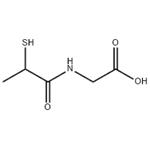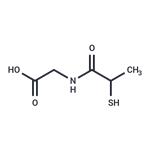- Tiopronin
-

-
2025-10-06
- CAS:1953-02-2
- Min. Order:
- Purity: 0.99
- Supply Ability:
- Tiopronin
-

- $29.00 / 1mL
-
2025-09-30
- CAS:1953-02-2
- Min. Order:
- Purity: 98.00%
- Supply Ability: 10g
- Tiopronin
-

- $0.00 / 1Kg/Bag
-
2025-09-29
- CAS:1953-02-2
- Min. Order: 1KG
- Purity: 98.5%min; CP/JP
- Supply Ability: 3500kg/month
|
| | Tiopronin Basic information |
| | Tiopronin Chemical Properties |
| Melting point | 93-98 °C | | Boiling point | 418.3±30.0 °C(Predicted) | | density | 1.249 (estimate) | | refractive index | 1.5216 (estimate) | | storage temp. | Inert atmosphere,2-8°C | | solubility | DMSO (Slightly), Methanol (Slightly) | | pka | 3.36±0.10(Predicted) | | form | solid | | color | White | | Merck | 14,9453 | | BRN | 1859822 | | InChI | InChI=1S/C5H9NO3S/c1-3(10)5(9)6-2-4(7)8/h3,10H,2H2,1H3,(H,6,9)(H,7,8) | | InChIKey | YTGJWQPHMWSCST-UHFFFAOYSA-N | | SMILES | C(O)(=O)CNC(=O)C(S)C | | CAS DataBase Reference | 1953-02-2(CAS DataBase Reference) |
| Hazard Codes | Xn | | Risk Statements | 22 | | Safety Statements | 36/37 | | WGK Germany | 3 | | RTECS | MC0596500 | | HS Code | 2930.90.4950 | | Toxicity | LD50 i.v. in mice: 2.1 g/kg (Fujimura) |
| | Tiopronin Usage And Synthesis |
| Description | Tiopronin is a sulfiydryl derivative of N-propylglycine useful in the treatment of cystine
urolithiasis in children. It is also reportedly effective in the management of rheumatoid
polyarthritis, possibly due to its inhibitory effect on the free oxygen radicals produced by
inflammatory macrophages and granulocytes. | | Description | Tiopronin is an antioxidant that has diverse biological activities. It reduces free radical production by murine macrophages and granulocytes in vitro in a dose-dependent manner. Tiopronin induces expression of hypoxia-inducible factor 1α (HIF-1α) and increases VEGF secretion in human colon carcinoma cells. Rectal administration (500 μL of a 10 mM solution) reduces myeloperoxidase activity and reduces pro-inflammatory cytokine production in the colon in a rat model of colitis. Tiopronin (80-320 mg/kg per day) reduces the incidence of cleft palate in fetuses born to female mice orally exposed to teratogenic methylmercury chloride. Tiopronin (100 mg/kg) reduces heme oxygenase 1 mRNA expression, lipid peroxidation, and transverse aortic constriction in a mouse model of cardiac hypertrophy. Tiopronin (20 mg/kg) is hepatoprotective, increasing activity of the antioxidant enzymes superoxide dismutase and glutathione peroxidase and reversing hepatocyte degeneration in a rat model of high-fat diet-induced non-alcoholic steatohepatitis. | | Chemical Properties | White Solid | | Originator | Roussel-Uclaf (Japan) | | Uses | It is used as antidote against heavy metal poisoning; hepatoprotectant; mucolytic. | | Uses | N-(2-Mercaptopropionyl)glycine or Tiopronin has been used:
- in the preparation of polyethylenimine (PEI)-coated gold microparticles (PEI-gold) for biolistic delivery of nucleic acids
- to study the role of reactive oxygen species (ROS) at the reperfusion stage in in vivo isoflurane preconditioning-induced neuroprotection
- as a ROS inhibitor to study its effect on lysophosphatidylcholine (LPC)-induced inflammasome activation
| | Definition | ChEBI: Tiopronin is a N-acyl-amino acid. | | Manufacturing Process | α-Benzylmercaptopropionic acid (melting point 76°C to 78°C; 100 g) prepared
by condensation of α-mercaptopropionic acid with benzyl chloride is allowed to
stand overnight with 80 g of thionyl chloride. After removal of excess thionyl
chloride distillation in vacuo gives 70 g of α-benzylmercaptopropionic acid
chloride of boiling point 138°C to 139°C/7 to 8 mm Hg.
Then, 25 g of glycine is dissolved in 165 ml of 2 N sodium hydroxide solution
and 70 g of α-benzylmercaptopropionic acid chloride and 100 ml of 2 N
sodium hydroxide solution are dropped thereinto simultaneously at 3°C to
5°C. The solution is then stirred at room temperature for 3 to 4 hours to
complete the reaction, the reaction solution is washed with ether, the aqueous
layer is acidified with hydrochloric acid, and the resulting crystals are collected
by filtration. These are recrystallized from a mixture of methanol and ethyl
acetate to give 60 g of α-benzylmercaptopropionylglycine of melting point
133°C to 134°C.
This α-benzylmercaptopropionylglycine (60 g) is dissolved in 400 ml of liquid
ammonia, kept at about -50°C, and 12 g of sodium metal is gradually added
thereto. After the reaction, excess ammonia is removed therefrom, the
residue is dissolved in water, washed with ether and the residual aqueous
layer is adjusted to pH 1 with hydrochloric acid and concentrated in vacuo in a
stream of hydrogen sulfide. The crystalline residue is dried and recrystallized
from ethyl acetate to give 25 g of α-mercaptopropionylglycine of melting point
95°C to 97°C. | | Brand name | Thiola | | Therapeutic Function | Antidote (heavy metal) | | Biochem/physiol Actions | N-(2-Mercaptopropionyl)glycine (NMPG) is a thiol compound associated with autoimmune hypoglycemia. It is a diffusible antioxidant and reduces the severity of colonic injury. NMPG also relieves myeloperoxidase activity and stimulates hypoxia-inducible factor-1 (HIF-1) - vascular endothelial growth factor (VEGF) pathway for ulcer healing. | | Veterinary Drugs and Treatments | Tiopronin is indicated for the prevention of cystine urolithiasis in
patients where dietary therapy combined with urinary alkalinization
is not completely effective. It may also be useful in combination
with urine alkalinization to dissolve stones. | | References | [1] Patent: CN106146365, 2016, A. Location in patent: Paragraph 0038; 0039 |
| | Tiopronin Preparation Products And Raw materials |
|